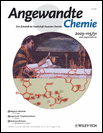Understanding the Window Effect in Zeolite Catalysis†
We would like to thank the Netherlands Research Council for Chemical Sciences (CW), the European Commission for a Marie Curie Fellowship to S.C., ChevronTexaco for financial support, and C. Wilson, C. H. Roemkens, A. Kuperman, S. I. Zones, and R. Krishna for their comments on our manuscript.
Graphical Abstract
Entgegen der traditionellen Auffassung, dass Crack-Reaktionen in Zeolithen mit vollständiger Substratadsorption verlaufen, deuten Rechnungen für ERI-, AFX-, CHA-, RHO- und KFI-Zeolithe auf geringe Adsorption von Substraten hin, die eine ähnliche Größe wie die Zeolithhohlräume haben. Sehr lange Moleküle werden in oberflächennahen Poren teilweise adsorbiert. Der nichtadsorbierte Teil kann abgespalten und in ein Produkt eingebaut oder erneut adsorbiert werden. Dieser Mechanismus ist charakteristisch für Zeolith-Käfige mit Fenstern, deren Größe etwa dem Adsorbatdurchmesser entspricht.





